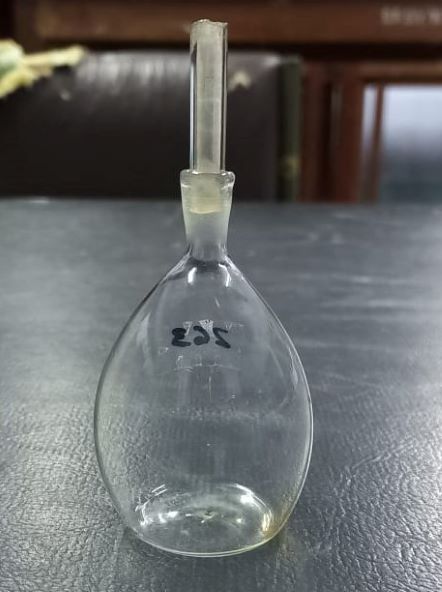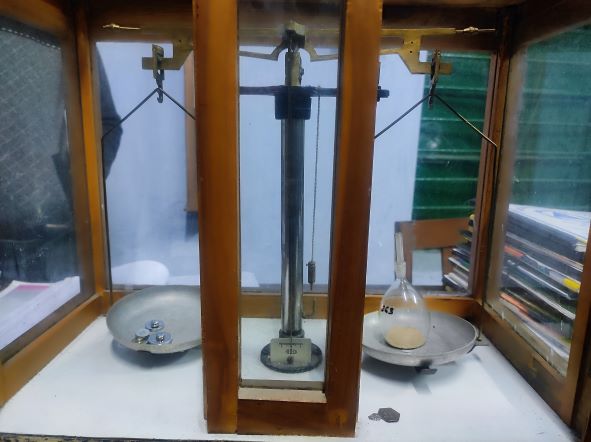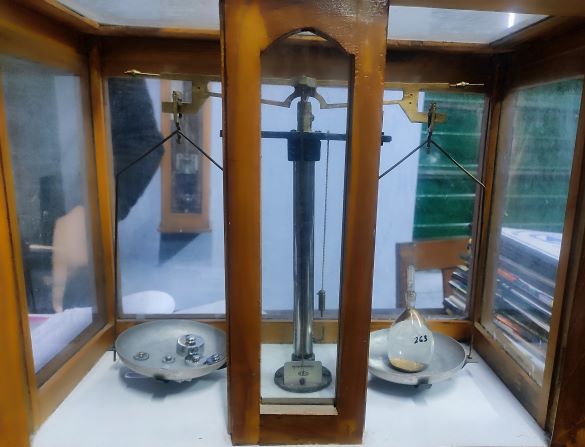This practical on specific gravity of sand experiment ( To determine the relative density of sand by using a specific gravity bottle) includes theory, apparatus, procedure, table for measurement, precautions and discussions and viva questions.
To determine the relative density of sand by using a specific gravity bottle
Theory
The specific gravity of a substance is defined as the ratio of the mass of the substance of given volume to the mass of water of equal volume at 40 C.
Let, the mass of the empty specific gravity bottle = W1 gm
mass of the bottle + sand = W2 gm
Mass of the bottle + sand + Mass of the water filling the remaining part of the bottle = W3 gm
Mass of the bottle + Mass of the completely filled water = W4 gm
So, the Mass of the sand = (W2 – W1) gm
Mass of water of volume equal to the bottle = (W4 – W1) gm
Mass of the water filling the remaining part of bottle = ( W3 – W2 ) gm
Mass of water equal to that of sand = [ (W4 – W1) – ( W3 – W2 ) ] gm
Specific gravity of sand, S is given by
S = \frac{mass \hspace{0.2cm} of \hspace{0.2cm}sand}{mass \hspace{0.2cm}of \hspace{0.2cm}equal\hspace{0.2cm} volume\hspace{0.2cm} of\hspace{0.2cm} water\hspace{0.2cm} at \hspace{0.2cm}4^{0}C}
S = \frac{mass \hspace{0.2cm} of \hspace{0.2cm}sand}{mass \hspace{0.2cm}of \hspace{0.2cm}equal\hspace{0.2cm} volume\hspace{0.2cm} of\hspace{0.2cm} water\hspace{0.2cm} at \hspace{0.2cm}t^{0}C} \times \frac{mass \hspace{0.2cm}of \hspace{0.2cm}equal\hspace{0.2cm} volume\hspace{0.2cm} of\hspace{0.2cm} water\hspace{0.2cm} at \hspace{0.2cm}t^{0}C}{mass \hspace{0.2cm}of \hspace{0.2cm}equal\hspace{0.2cm} volume\hspace{0.2cm} of\hspace{0.2cm} water\hspace{0.2cm} at \hspace{0.2cm}4^{0}C}
S = \frac{W_{2}-W_{1}}{(W_{4}-W_{1})-(W_{3}-W_{2})} \times Specific \hspace{0.2cm} gravity \hspace{0.2cm} of \hspace{0.2cm} water \hspace{0.2cm} at \hspace{0.2cm} t^{0}C
S = S^{'} \times S_{W}
Apparatus
- Specific gravity bottle
- Common balance
- Weight box
- Sand
- Blotting paper
- Thermometer
Procedure
- The room temperature or the temperature of water is noted by using a thermometer.
- The common balance is levelled.
- The specific gravity bottle is cleaned and dried before measurement. The mass of the empty bottle (W1) is noted.
- The specific gravity bottle is partly filled (approximately one third of the volume of bottle) with sand and the mass of the bottle and sand is measured (W2).
- The remaining part of the bottle is filled with water and the measured mass for the bottle with sand and water is noted. Let the mass be W3
- The sand and water is completely removed from the bottle and filled with water only. The mass of the specific gravity bottle filled with water is measured to be W4.
- The steps mentioned in point 3 to 6 are repeated for 3 to 5 times. Specific gravity of sand is calculated using the formula mentioned in theory.




Results
Temperature of water = ______ 0 C
Specific gravity of water at that temperature, SW = ________
Table for determination of specific gravity of sand
| No. of Obs. | mass of the empty specific gravity bottle (W1 gm) | mass of the bottle + sand (W2 gm) | Mass of the bottle + sand + Mass of the water filling the remaining part of the bottle (W3 gm) | Mass of the bottle + Mass of the completely filled water ( W4 gm) | Specific gravity of sand S’ | Average S’ | S = S^{'} \times S_{W} |
| 1 2 3 4 5 |
Precautions and Discussions
- The specific gravity bottle should be cleaned before each and every measurement.
- When the bottle is filled with water, it should be checked that no air bubble is inside the bottle.
- The common balance should be checked before use.
- The excess liquid should be wiped out from thee bottle by using blotting paper.
Find more laboratory experiments of physics. click here
Viva questions on specific gravity of sand experiment or practical (To determine the relative density of sand by using a specific gravity bottle)
1. What is the use of common balance?
Answer: Common balance is used to measure the mass of an object.
2. What is the use of spring balance?
Answer: Spring balance is used to measure the weight of an object.
3. Why we cannot measure the weight of a body directly from common balance.
Answer: In common balance, we compare the mass of the given object with that of a standard mass. We can calculate the weight of the body by simply multiplying the acceleration due to gravity with the measured mass.
4. Is there any unit of specific gravity?
No. Specific gravity has no unit. It is the ration of two similar physical quantity.
5. Define specific gravity.
Answer: The specific gravity of a substance is defined as the ratio of the mass of the substance of given volume to the mass of water of equal volume at 40 C.
6. Does specific gravity depend on temperature?
Answer: Yes
7. If air bubble remain in the specific gravity bottle, what kind of error may come?
Answer: If air bubble remains in the bottle, the measured volume of water will be less than the real volume.
8. Does the specific gravity vary at different places on earth?
Ans: No, the specific gravity remains constant in all places on earth.
9. How do you calculate density in CGS system from specific gravity measurement.
Ans: In CGS system, the values of density and specific gravity are same.